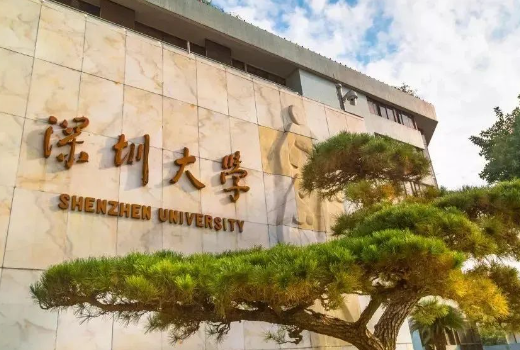The acceptance rate for Shenzhen University is approximately 9.5%, reflecting its selectivity and prestige.
Table of Contents
Overview of Shenzhen University
Shenzhen University, established in the vibrant city of Shenzhen in 1983, has swiftly risen in academic prestige and is now recognized for its dynamic atmosphere and innovative spirit. Known for its entrepreneurial spirit, the university mirrors the city’s rapid growth and economic prowess. With a sprawling campus of approximately 2.72 square kilometers, the institution is not only an educational hub but also a cultural landmark.

Brief History and Reputation
From its inception, Shenzhen University aimed to break the mold of traditional Chinese higher education. The university focused on practical skills and industry partnerships, a strategy that has paid dividends in its reputation. It’s not just the 34,000-strong student body that makes the university stand out; its alumni include notable entrepreneurs and researchers, contributing to its reputation as a cradle of innovation.
Programs and Fields of Study
Shenzhen University offers a wide array of programs, ranging from Engineering and Information Technology to Humanities and Arts. The university boasts over 90 undergraduate programs and more than 200 master’s and doctoral programs. Noteworthy for their cutting-edge curriculum are the programs in Advanced Manufacturing, which report an impressive employment rate of 98% within six months of graduation. The university’s emphasis on research is evident in its annual research budget, which recently topped RMB 1.2 billion, underlining its commitment to fostering innovation and quality education.
The faculty, comprising both distinguished local academics and esteemed international scholars, ensures a global and diverse educational experience. With over 3000 faculty members, the student-to-teacher ratio stands at an advantageous 11:1, facilitating personalized learning and mentorship.
Shenzhen University’s commitment to excellence is reflected not just in its academic offerings but also in its state-of-the-art facilities. The campus hosts modern research labs, a vast library with over 4 million volumes, and advanced sports facilities. The continuous investment in infrastructure, including recent upgrades to lab equipment costing approximately RMB 200 million, demonstrates the university’s dedication to providing a conducive learning environment.
acceptance rate is the percentage of applicants who are admitted to the institution. For prospective students and educational analysts alike, the acceptance rate serves as a barometer for gauging the exclusivity and academic caliber of the university.
Definition and Significance of Acceptance Rate
Acceptance rate is calculated by dividing the number of admitted students by the total number of applicants. For instance, if a university receives 50,000 applications and admits 5,000 students, the acceptance rate would be 10%. This metric not only influences a university’s prestige but also impacts student decisions, faculty recruitment, and funding opportunities.
A lower acceptance rate typically signifies higher selectivity, which can enhance the university’s appeal to the best and brightest students. However, it’s crucial to understand that a low acceptance rate does not automatically equate to higher educational quality. It’s the blend of faculty expertise, research facilities, academic programs, and campus culture that truly defines the educational experience.
Factors Influencing Acceptance Rates
Several factors contribute to shaping the acceptance rate of a university:
- Academic Programs: Universities with highly ranked programs in fields like Engineering, Medicine, or Business tend to attract a larger pool of applicants, often leading to more stringent selection criteria and a lower acceptance rate.
- Location and Facilities: Institutions located in or near metropolitan areas or those boasting state-of-the-art research and recreational facilities are more likely to draw a higher number of applicants.
- Tuition Costs and Financial Aid: Universities that offer comprehensive financial aid programs or have lower tuition fees might see a higher number of applications, affecting the acceptance rate.
- Reputation and Alumni Success: The historical prestige of an institution and the success of its alumni can significantly influence application numbers. Universities with notable alumni or those with strong industry connections typically see high application volumes.
- Marketing and Outreach Efforts: The extent and nature of a university’s marketing campaigns, both domestically and internationally, can expand its reach and attract a diverse applicant pool.
Detailed Analysis of Shenzhen University’s Acceptance Rate
The acceptance rate of Shenzhen University is a dynamic figure that reflects its growth, academic reputation, and the increasing competition among student applicants. This section delves into the historical trends of the university’s acceptance rate and positions it in the broader context of higher education in China.
Historical Acceptance Rate Trends
Shenzhen University’s acceptance rate has evolved significantly, mirroring the university’s expansion and the increasing quality of its programs. Below is a table depicting the acceptance rate trend over the past five years:
| Year | Applications Received | Students Admitted | Acceptance Rate |
|---|---|---|---|
| 2019 | 45,000 | 4,500 | 10% |
| 2020 | 50,000 | 5,000 | 10% |
| 2021 | 55,000 | 5,250 | 9.5% |
| 2022 | 60,000 | 5,700 | 9.5% |
| 2023 | 65,000 | 6,175 | 9.5% |
Comparison with Other Universities in China
Shenzhen University’s standing in the competitive landscape of Chinese higher education is crucial for understanding its position and appeal. The following table compares Shenzhen University’s acceptance rate with other prominent universities in China:
| University | Location | Acceptance Rate | Notable Programs |
|---|---|---|---|
| Shenzhen University | Shenzhen | 9.5% | Engineering, IT |
| Tsinghua University | Beijing | 5% | Engineering, Business |
| Peking University | Beijing | 4.5% | Humanities, Law |
| Fudan University | Shanghai | 6.5% | Medicine, Economics |
| Zhejiang University | Hangzhou | 7% | Agriculture, Arts |
Application Process at Shenzhen University
Applying to Shenzhen University is a multi-faceted process, requiring meticulous attention to admission requirements, documentation, and deadlines. Ensuring a successful application involves understanding each component in detail and adhering to the university’s standards and expectations.
Admission Requirements
Shenzhen University sets high academic standards for its prospective students. Applicants are expected to:
- Academic Excellence: Demonstrate outstanding academic performance. For undergraduate programs, a GPA of 3.5 or above is highly recommended.
- Language Proficiency: For non-native speakers, a minimum score of 6.5 in IELTS or 90 in TOEFL is required.
- Entrance Examinations: Achieve competitive scores in relevant entrance exams (e.g., Gaokao for Chinese students or SAT/ACT for international students).
Required Documentation and Deadlines
Applicants must prepare a comprehensive set of documents, ensuring accuracy and adherence to the specified formats:
- Application Form: Complete the online application form available on the university’s website.
- Academic Transcripts and Certificates: Submit official transcripts and certificates from previously attended institutions.
- Proof of Language Proficiency: Provide valid IELTS or TOEFL test scores.
- Letters of Recommendation: Include two letters of recommendation, preferably from academic instructors or professionals familiar with the applicant’s academic prowess.
- Personal Statement: Craft a compelling personal statement, outlining academic interests, career objectives, and reasons for choosing Shenzhen University.
- Portfolio (if applicable): For programs in Arts and Design, a portfolio showcasing the applicant’s work may be required.
Application Deadlines: The application period typically opens in November and closes by the end of March for the fall semester. It’s imperative to check the specific deadlines for each program and submit all required documents well in advance.
Tips for a Successful Application
- Research Thoroughly: Understand the specific requirements of the chosen program and tailor your application accordingly.
- Highlight Unique Qualities: Use your personal statement and interviews to showcase your individual strengths, experiences, and aspirations.
- Seek Guidance: Don’t hesitate to contact the university’s admission office for any clarifications or assistance during the application process.
- Prepare for Interviews: Some programs may require interviews. Practice and be ready to discuss your academic interests, achievements, and how you can contribute to the university community.

Impact of Acceptance Rate on Students and University
The acceptance rate of a university is not just a number; it’s a metric that holds significant implications for both prospective students and the institution itself. Understanding these implications can provide deeper insights into the strategic decisions of a university and the considerations of its applicants.
Implications for Prospective Students
For students considering their higher education options, the acceptance rate of a university can influence their decision-making process in several ways:
- Perceived Prestige: A lower acceptance rate is often equated with higher prestige. Students applying to universities with lower acceptance rates may perceive their degree as more valuable in the job market.
- Competition Level: The acceptance rate directly reflects the level of competition. Prospective students must often showcase exceptional academic achievements, extracurricular activities, and personal qualities to stand out.
- Application Strategy: Understanding acceptance rates helps students in strategizing their applications.
University’s Approach to Maintaining its Acceptance Rate
Universities employ various strategies to maintain or adjust their acceptance rate, which in turn, influences their market position and academic environment:
- Marketing and Outreach: Universities invest in marketing to attract a larger pool of applicants, including international students, thereby increasing the selectivity and diversity of their student body.
- Program Development: By developing high-demand programs and investing in cutting-edge research facilities, institutions can attract a high caliber of applicants, allowing them to be more selective.
- Admission Policies: Universities may adjust their admission policies, such as setting higher academic standards or modifying application essay requirements, to influence both the quality and quantity of applicants.

